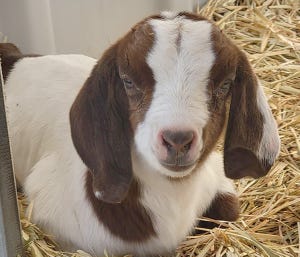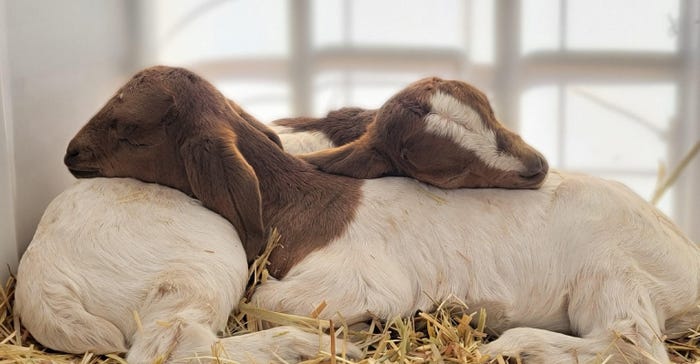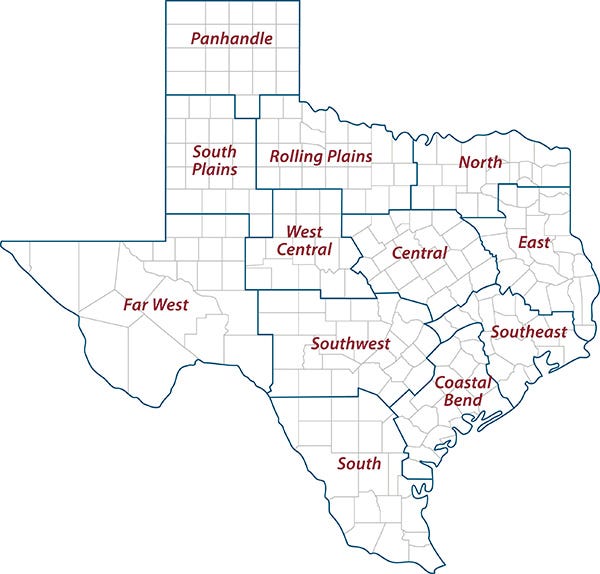
Texas lamb and goat meat producers continue to command high prices in a niche market driven by high demand and low supplies, according to a Texas A&M AgriLife Extension Service expert.
Reid Redden, AgriLife Extension sheep and goat specialist and interim director of the Texas A&M AgriLife Research and Extension Center, San Angelo, said the Texas lamb and goat markets have thrived despite COVID-19 and that travel restrictions likely helped spur demand higher.
“The lamb and goat markets are in another world as it relates to market conditions most Texas ag producers have been dealing with,” he said. “The market for Texas lambs and goats is diverse, resilient and growing. It avoided supply chain bottleneck issues other livestock markets dealt with, and I think the COVID restrictions kept the regular consumers home, which means more family functions to eat lamb and goat meat.”
Lamb in high demand
Texas producers continue to command top prices as they supply a niche market around the U.S., Redden said.
 (Photo by Shelley E. Huguley)
(Photo by Shelley E. Huguley)
In January, the base price for 60-pound lightweight slaughter lambs was $3 per pound, up 70 cents per pound from this time last year, he said. Those lambs are selling $1 per pound over the five-year rolling average.
Overall, consumer demand for lamb has expanded in recent years. But Redden said Texas lambs have commanded premium prices through the non-traditional market compared to the traditional market for restaurants or retail sale.
The traditional feeder market, which prefers larger framed, wool-type lambs fed to 140-180 pounds, and mimics the beef industry as far as processing and logistics, is not as common in Texas as it used to be, he said. The vast majority of Texas lambs are smaller-framed hair sheep that typically weigh 40-80 pounds – and go to ethnic consumers.
Prices for Texas lambs are driven primarily by the demand from nontraditional ethnic consumers, who are concentrated in major populations centers around the state and nation, Redden said.
Lambs are shipped live to the markets where they are sold directly to consumers or harvested by ethnic processors and distributed to ethnic grocers and butcher shops. These non-traditional markets demand smaller, leaner lambs and pay a premium for them.
“The market has been strong for some time now, but prices continue to trend upward,” he said.
Prices reflecting demand
Lamb production is limited in the U.S. because very few regions have climates and production conditions that sheep perform well in compared to other livestock.
Redden said Western parts of Texas are ecologically perfect for sheep. Native plant species include many varieties of browse that sheep find palatable, and the arid conditions make controlling internal parasites easier.
A significant piece of the traditional U.S. lamb market is supplied by imports and they are one-third to half the cost of domestic lamb, but imported lamb do not appear to have as large an effect on the ethnic market supplied by Texas lambs and goats, he said.
Many consumers want lambs at 40-60 pounds, but producers are realizing better margins at 60-80 pounds, Redden said. These market conditions factor into maintaining and inflating strong prices as buyers jockey for specific weight and class lambs.
“It’s a specialty market, and it’s become harder and harder for supplies to meet demand,” he said. “The prices reflect that.”
Goat prices strong, getting stronger
Goat prices continued to experience a price trajectory similar to lamb, Redden said.
“The kid goat market is even brighter than lambs,” he said. “The goat market has been on fire the last several years and getting better and better. Producers don’t understand it, but they’re just riding the wave as far as it will go.”
Unlike Texas’ lamb market, goats have never been part of the traditional meat production apparatus, Reid said. There are no big processing plants or packers, and production feeds non-traditional, primarily ethnic demand.
From January and February, goat prices fluctuated between $3.50-$3.80 per pound compared to a five-year average of $2.50-$2.75 for the same time of season. January-March is typically when prices are the best. Kidding season is just now getting started and most market goats are sold in the summer and fall.

Goats are lighter, slower-growing animals compared to sheep, Redden said. Market kid goats tend to be lighter than lambs – typically averaging 35-65 pounds – but are achieving comparable prices per head due to higher prices. Some goats have brought over $4 per pound at market.
“There was one down week last year when buyers were worried about the COVID-19 pandemic, but as soon as the orders kept coming in, prices took off and have continued to climb,” Redden said. “There just aren’t enough goats to meet demands.”
Redden said it was noteworthy that even the cull nanny market was very strong, meaning buyers are willing to pay top dollar for less desirable goats. They were selling at $2.20 per pound in February, 85 cents per pound above the five-year February average for 100-pound nanny goats of $1.35 per pound.
Redden said goats, like Texas lambs, are in high demand in major population centers across the state and country. While lambs are more adaptable to other production conditions, western parts of Texas are ideal for goat production due to browse requirements and low internal parasite load.
About 40% of U.S. goat production is located in West Central and West Texas, Redden said. About 30% of goats consumed in the U.S. come from imports. Australia has been a major player in the import market, but their goats are primarily feral herds, and they aren’t able to increase production to meet the growing demand. As such, imports have very little impact on domestic goat prices.
“You see people with a few hobby goats here and there, but the major producers who are experienced with the infrastructure and know-how to handle a commercial goat herd are generally located in Texas,” he said. “There’s interest in goat production because prices have been so good, but they are a lot of work, and I don’t predict large increases in goat production outside the state.”
AgriLife Extension district reporters compiled the following summaries:

CENTRAL
Warmer and drier conditions returned, but there was widespread damage from the Arctic blast. Soil conditions were still a bit cool and wet for corn planting, but first plantings were expected to begin soon. Producers were entering planting season with optimism due to higher prices for corn, sorghum and cotton. Corn and sorghum acres were expected to be up somewhat in response to better pricing. Availability of sorghum seed was tightening following increased seed deliveries to some distributors. Pasture grasses and rangelands were greening up but exhibited little new growth. Livestock were moved onto the short fresh grass and looked to be in good condition. Winter wheat crops and oat forages recovered very well from the freeze damage. Some winter wheat reached early jointing stage. Stock tanks were beginning to show reduced levels with limited runoff. The weather outlook called for a dry, warm spell in the near term. Almost all counties reported adequate soil moisture levels.
ROLLING PLAINS
Conditions were warm and dry. Wheat fields showed signs of improvement since the recent freeze damage. Cattle producers continued supplementing cow/calf and stocker operations with protein supplements and hay where forages were limited.
COASTAL BEND
Warm and humid conditions prevailed with a front delivering a little precipitation. Some areas reported wet fields, but others reported short topsoil moisture. Producers planted corn, sorghum and cotton in fields they were able to access with planters. Producers also sprayed for weeds and fertilized hay fields and improved pastures. Ryegrass and clover pastures looked good, but oat pastures showed significant freeze damage. Some pastures were greening up, but some were short on moisture. Livestock producers were still providing supplemental hay and protein. Some producers ran short on hay and were trying to stretch supplies. Spring calving continued. Cattle were in fair to good condition, and prices at sale barns were steady.
EAST
Warmer weather was welcome as the district began to recover from the winter storm. Some counties were greening up, and winter pastures were doing well while others were still struggling to recover from the freeze. Pasture and rangeland conditions were fair. Subsoil and topsoil conditions were adequate. Cattle numbers were down at sale barns, but prices were up. Livestock were doing fair to good with supplemental feeding taking place. Wild pigs were active.
SOUTH PLAINS
Drought conditions continued. High winds were in the forecast. Cattle were in good condition.
PANHANDLE
Soil moisture levels were very short to short across most of the district with some areas reporting adequate moisture. Weather conditions were warmer, drier and windier, which was hurting moisture levels. Pasture and rangeland conditions were reported very poor in most parts with a few areas reporting fair conditions. Winter wheat was in poor to fair condition in most areas and good to excellent in a few areas. Wheat producers were topdressing fertilizer and spraying weeds. Wheat was beginning to come out of winter dormancy and grow. Some irrigated producers were expected to begin irrigating if no rainfall arrived soon. Fieldwork began on corn, cotton and grain sorghum acres with tillage and preplant herbicide and fertilizer applications. Cattle on rangelands were still receiving supplemental feed.
NORTH
Topsoil moisture throughout the district was mostly adequate. Temperatures were above 50 degrees for most of the reporting period. Some counties received around 3 inches of rain, which added to the already soaked pastures and made it impossible for farmers to access fields. Other counties reported sunny days and wind began drying up standing water in pastures. Winter wheat was starting to recover from the extreme freeze. Livestock pastures were starting to sprout with ryegrass, and winter pasture conditions were starting to improve. Livestock were in good shape. Spring calving was in full swing. Winter pastures, both planted and volunteer ryegrass, benefited from the sunshine and warmer temperatures.
FAR WEST
Temperature lows were in the mid-20s with highs in the mid-80s. Most areas were dry, and some burn bans remained, but some producers reported better than expected soil moisture levels. Some light snow accumulation was the only reported precipitation. High winds were reported with gusts up to 25 mph. Farmers were preparing fields in the northern part of the district for planting. Some producers were choosing to plant Pima cotton in fields that have been fallow for more than five years. Beef cattle were in overall good condition despite grazing conditions. Wheat was beginning to grow some with a little moisture and warmer temperatures. Wheat affected by the extreme cold was putting on new growth. Late-planted wheat was beginning to tiller and grow new leaves, and it was still uncertain whether late-emerging wheat will have enough time to make a crop. A few winter grain mites were found in some wheat fields but at low levels and may not meet treatment thresholds. Trees were beginning to bud, and new shoots of grass were beginning to appear in limited amounts. Some producers continued to repair damage from the last freeze. In El Paso County, the Water Improvement District No. 1 will allot very little water this season due to drought conditions in Southern Colorado and Northern New Mexico. Some effluent water was available to certain areas of the Lower Valley, and some well water was expected to be used. The Upper Valley will rely solely on wells. Cotton pre-irrigation was occurring within those specific areas. Some pecan orchards were receiving water as well.
WEST CENTRAL
Weather conditions were relatively warm. Winter wheat bounced back quickly and continued to improve as spring growth began. Rangeland and pasture conditions improved somewhat with warmer weather. Some field preparations began for spring planting. Dry conditions continued to prevail and the entire district needed rain. Freeze damage to young and non-native trees was becoming more apparent. Supplemental feeding of livestock was still heavy as calving and lambing season began.
SOUTHEAST
Pastures were still behind schedule from the freeze. Soil moisture levels were drying but remained too wet in some areas to access fields. Most cool-season forages were rebounding well from the excessive cold weather. Hay stores were short due to extra feeding during the winter storm. The freeze killed developing oat fields and damaged wheat fields. Ryegrass and other cool-season grasses were recovering. Livestock appeared to be recovering well from the winter storm. Rangeland and pasture ratings were fair to very poor with poor ratings being the most common. Soil moisture levels ranged from adequate to surplus with adequate being the most common.
SOUTHWEST
Seasonal temperatures returned with no precipitation reported across the district. Moisture received from the winter storm helped new growth as the growing season began. Producers were starting to plant corn. Caldwell County reported oats and wheat damaged by the hard freeze looked to be recovering. Cattle prices were still low while sheep and goat markets remained steadily high. Livestock conditions were fair to good. Producers continued to provide supplemental feed for livestock.
SOUTH
Soil moisture levels were short to very short throughout most of the district with a few areas reporting adequate soil moisture. Temperatures were mild with no rainfall reported. Corn planting started. Wheat and oat crops continued to improve but recovery was hindered by lack of moisture. Some wheat and oat fields were disced up after the freeze. Pasture and rangeland conditions were poor, but winter weeds were beginning to regrow or sprout. Most improved and native forages were still recovering from the freeze. Bermuda grass hay fields were under irrigation, and supplemental feeding of livestock continued. Mesquite trees and black brush were still dormant. Native prickly pear cactus was hit hard by the freeze, and most plants have sections that collapsed. Spring row crop planting dates were falling behind due to dry conditions and very cold mid-February temperatures. Some row crop producers were planting early to take advantage of remaining soil moisture. Corn and sorghum plantings were in full swing in southern parts of the district, and some cotton acres were planted. Livestock and wildlife diets were being supplemented. Some cattle were receiving heavy rations of hay and protein, and many producers were culling herds as needed. Hay supplies were declining, and prices were at $65-$75 per round bale. Cattle prices were steady. The effects of the hard, sustained freeze on trees and brush were being assessed. Ryegrass was in good shape and greening up. Farmers were preparing soil for vegetables, and some were already planting. Pecan trees under irrigation looked good. Water tanks were low due to lack of rain and damage to water system lines during the freeze. Sunflowers were planted, but sesame plantings were still on hold. Onions and sugarcane were being harvested. Unharvested citrus was lost to the freeze, and very little greening in citrus trees was reported as damage assessments continued.
About the Author(s)
You May Also Like




